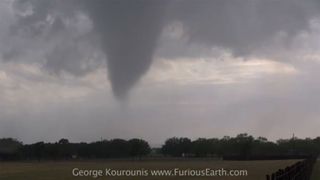
What Explains the Recent Outbreak of Tornadoes?

Tornado season has been relatively quiet this year. There were only 72 tornadoes nationwide in April, 70 percent below the 10 year average, according to the Weather Channel. But within in the last week, tornado outbreaks have been erupting from North Texas to Minnesota.
Why do these tornadoes seem to be hitting all of a sudden?
An eastward advancing cold front is to blame. This pocket of cold air has run into warm air from the Gulf of Mexico. Like a wedge, the cold front has caused the warm air to rise, since it's less dense, said Jeff Weber, a scientist with the University Corporation for Atmospheric Research in Boulder, Colo.
"It's kind of the perfect setup," Weber told LiveScience.
This rising warm air has created thunderstorms that have in turn spawned tornadoes, which draw their rotation from the system's abundant wind shear, which is a change in wind speed and direction with altitude. In this case, winds have blown north off the Gulf of Mexico, and interacted with currents moving east along with the cold front, Weber said. This helps create swirling gyres that can be flipped vertically and create tornadoes, he said. [Infographic: Tornado! How, When & Where Twisters Form]
This follows a relatively calm spring that saw few tornadoes, which is largely due to unusually cold temperatures throughout much of the country. The cold can in turn be blamed on the fact that the jet stream, the ribbon of wind that stretches across the Northern Hemisphere, dipped farther south than usual. This brought with it frigid Arctic air and prevented warm, moist air from the Gulf of Mexico from advancing northward.
Last week, with the jet stream shifting north and the atmosphere more conducive to tornado formation, an outbreak of an estimated 16 twisters erupted in North Texas on May 15. The tornadoes ranged in strength from an EF-1 in the town of Millsap that caused damage to roofs, to an EF-4 in Granbury that completely destroyed houses.
Sign up for the Live Science daily newsletter now
Get the world’s most fascinating discoveries delivered straight to your inbox.
The Texas tornadoes were worsened by the fact that the jet stream dipped south during this outbreak, adding extra rotational power to the twisters, Weber said.
In the next few days, this system should soon weaken, Weber said. That's because the center of the cold front's circulation is now over Minnesota and Wisconsin, and warm air has filled the center of the country. This means there will be less interaction between masses of cold and warm air, which fuel tornadoes' destructive power, Weber said.
The Weather Channel stat comes from a tweet by meteorologist Mike Bettes.
Email Douglas Main or follow him on Twitter or Google+. Follow us @livescience, Facebook or Google+. Article originally on LiveScience.com.
